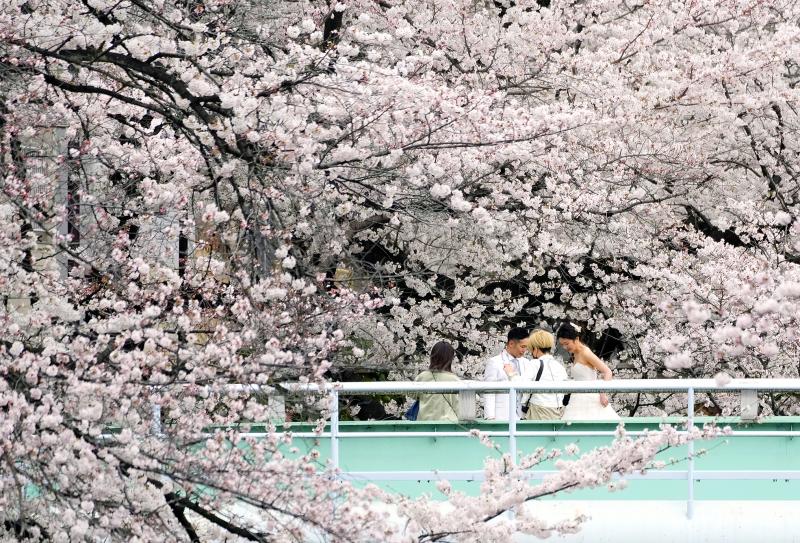The wait to see the doctor at Japan’s popular fertility clinic Saint Mother Hospital just got longer.
Starting yesterday, public health insurance will reimburse 70 percent of the costs of advanced fertility treatments as part of the government’s attempt to halt a decline in one of the world’s fastest-aging populations.
Atsushi Tanaka, doctor and director of Saint Mother in Kita Kyushu, southern Japan, expects more patients at his clinic, already packed with couples seeking treatments such as in-vitro fertilization (IVF) which previously cost over 500,000 yen (US$4,090) per cycle — more than the average household’s monthly income.

Photo: EPA-EFE
“I think we’ll see a huge number of patients,” he said, adding that nationwide IVF attempts may even double.
Yet Tanaka and other specialists say this won’t be enough to reverse Japan’s demographic decline, with patients still facing considerable costs, and insurance coverage excluding procedures such as genetic screening and the use of donor eggs. With the number of women of child-bearing age dropping off in the coming years, they said, the government needs to do more.
Japan’s experience will serve as a test case for advanced economies facing declining birth rates. While free, or mostly free, IVF treatments are already available in a handful of countries including Denmark and France, Japan is the biggest economy to subsidize most costs for such treatments.
It already has one of the world’s biggest number of women trying IVF. One in 14, or about 7 percent of babies, were conceived through IVF in 2019, compared with 2 percent in the US. Yet its birthrate still hovers around 1.3, far below the 2.1 rate the OECD says is needed to sustain a stable population.
The move is the latest attempt to encourage younger people to have babies. Over the past decade, it has expanded financial subsidies for daycare and monthly allowances to families with children. Japan’s childcare leave policies are already among the most generous in the world, although few fathers take full advantage of what’s offered, due to social and work pressure.
The government had already offered some financial assistance to lower-income couples seeking fertility treatment, but the latest change aims to provide access for a broader population seeking IVF, including methods such as injecting sperm into the uterus during ovulation and the use of frozen embryos.
COST CONCERNS
Policymakers hope the insurance coverage will encourage couples, who are grappling with years of low wages amid a weak economy, to try treatment sooner.
“It’s good that it will lower the bar for people in their early 30’s who need IVF treatment but were waiting for their bonus payments,” said Yuko Imamura at Health and Global Policy Institute, a Tokyo-based independent think-tank focusing on health policy.
Yet for Yuki Yano and her husband, who have been trying to conceive for a few years, treatments such as IVF are still too expensive. Even with insurance coverage, they may need to pay around 150,000 yen per cycle.
“The two of us are barely making ends meet as it is, and we don’t have the money to pay hundreds of thousands of yen for IVF,” said the 31-year-old.
For now, she is sticking to Clomid, a drug which helps stimulate ovulation. Since suffering an ectopic pregnancy that required the removal of one fallopian tube, she has found treatment stressful, particularly when her husband — a long-distance truck driver — is away during peak fertility days. “It’s hard, to be honest. And I just get older in the meantime.”
To pay for the new coverage, the government has set aside 17.4 billion yen in the budget for the fiscal year that began on yesterday. Analysts say it’s hard to say whether the spending will pay off. South Korea’s birthrate continues to decline despite expanded public insurance coverage of fertility treatments, although some studies on countries such as Denmark are more encouraging.
Saint Mother’s Tanaka said the government should consider helping to pay for egg freezing, a costly treatment not covered by public insurance. Companies like Google have offered female employees the chance to freeze their eggs, giving them greater freedom to pursue careers and family planning.
“The government is telling women to work. But they’re also telling women to have children sooner, and isn’t that contradictory? This is a solution,” he said. He also supports insurance coverage of methods such as time-lapse monitoring or preimplantation genetic testing, technologies credited for higher success rates.
But many women say it’s not just about medical treatment. A recent study by Sumitomo Life Insurance Co. found that a majority of Japanese women thought it was impossible to pursue both fertility treatment and work.
Megumi Takai, 33, plans to leave her full-time office job soon, and work part time to focus more on fertility treatment. She said many women were unable to use time off for doctor appointments, feeling it was too sensitive a subject to bring up at work.
“I wish society were more supportive about this, and that everyone could take time off when needed,” she said.

“How China Threatens to Force Taiwan Into a Total Blackout” screamed a Wall Street Journal (WSJ) headline last week, yet another of the endless clickbait examples of the energy threat via blockade that doesn’t exist. Since the headline is recycled, I will recycle the rebuttal: once industrial power demand collapses (there’s a blockade so trade is gone, remember?) “a handful of shops and factories could run for months on coal and renewables, as Ko Yun-ling (柯昀伶) and Chao Chia-wei (趙家緯) pointed out in a piece at Taiwan Insight earlier this year.” Sadly, the existence of these facts will not stop the

Taiwan is one of the world’s greatest per-capita consumers of seafood. Whereas the average human is thought to eat around 20kg of seafood per year, each Taiwanese gets through 27kg to 35kg of ocean delicacies annually, depending on which source you find most credible. Given the ubiquity of dishes like oyster omelet (蚵仔煎) and milkfish soup (虱目魚湯), the higher estimate may well be correct. By global standards, let alone local consumption patterns, I’m not much of a seafood fan. It’s not just a matter of taste, although that’s part of it. What I’ve read about the environmental impact of the

It is jarring how differently Taiwan’s politics is portrayed in the international press compared to the local Chinese-language press. Viewed from abroad, Taiwan is seen as a geopolitical hotspot, or “The Most Dangerous Place on Earth,” as the Economist once blazoned across their cover. Meanwhile, tasked with facing down those existential threats, Taiwan’s leaders are dying their hair pink. These include former president Tsai Ing-wen (蔡英文), Vice President Hsiao Bi-khim (蕭美琴) and Kaohsiung Mayor Chen Chi-mai (陳其邁), among others. They are demonstrating what big fans they are of South Korean K-pop sensations Blackpink ahead of their concerts this weekend in Kaohsiung.

The captain of the giant Royal Navy battleship called his officers together to give them a first morsel of one of World War II’s most closely guarded secrets: Prepare yourselves, he said, for “an extremely important task.” “Speculations abound,” one of the officers wrote in his diary that day — June 2, 1944. “Some say a second front, some say we are to escort the Soviets, or doing something else around Iceland. No one is allowed ashore.” The secret was D-Day — the June 6, 1944, invasion of Nazi-occupied France with the world’s largest-ever sea, land and air armada. It punctured Adolf